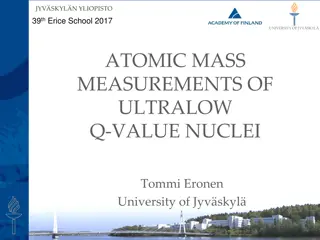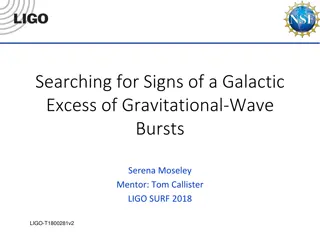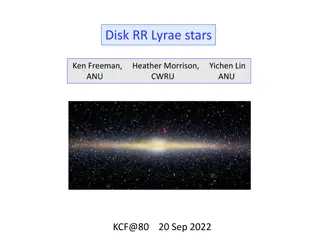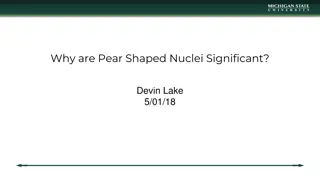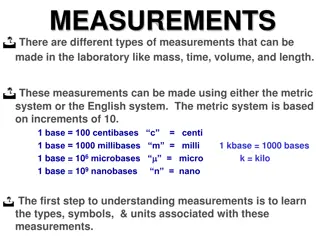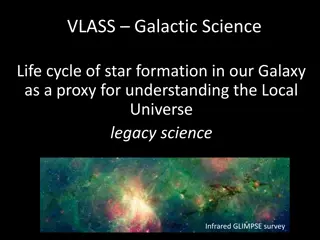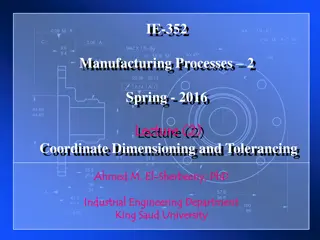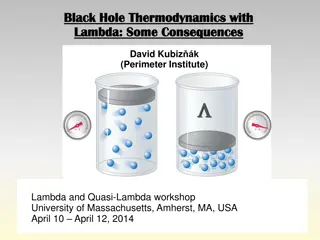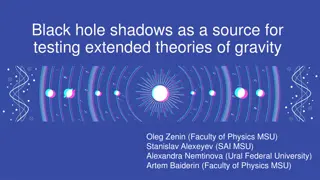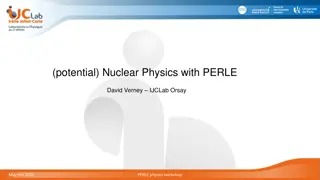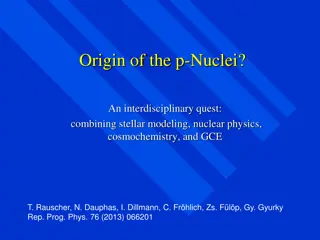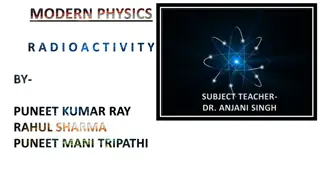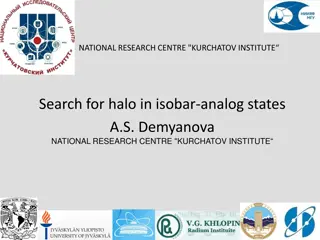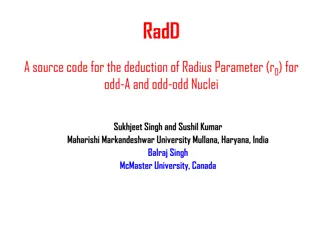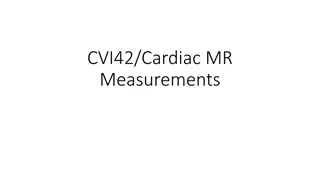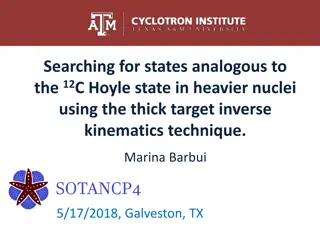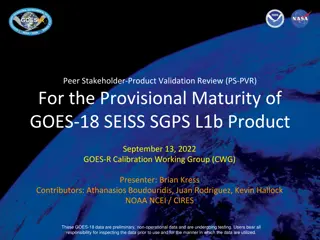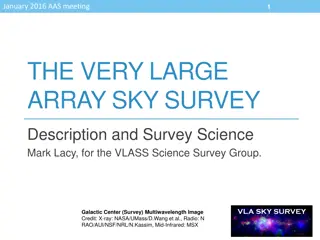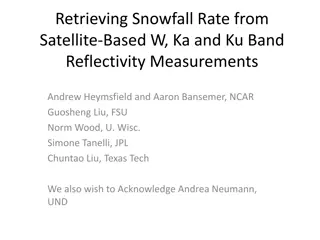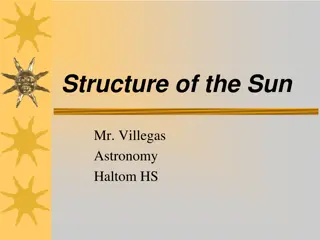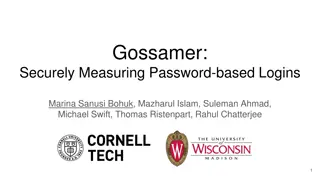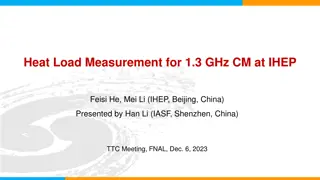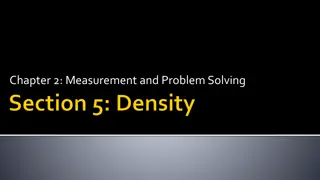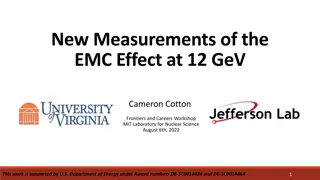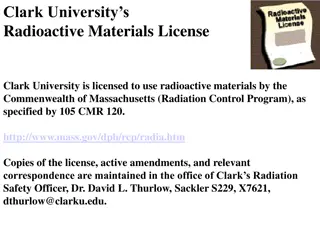Understanding Active Galactic Nuclei and Black Hole Mass Measurements
Exploring active galactic nuclei (AGN) through reverberation mapping techniques to measure black hole masses, observing AGN schematics, ultraviolet-optical AGN spectra, and methods for measuring masses in space. Delve into the current understanding of AGN fields, the future prospects, and ongoing research at Wyoming. Learn about the galactic core observations in the Milky Way and massive black holes like Gargantua. Discover the application of virial relationships in estimating black hole masses in quasars and the fascinating concept of reverberation mapping. Investigate the study on whether the Broad Line Region (BLR) follows the virial theorem based on AGN observations.
Download Presentation

Please find below an Image/Link to download the presentation.
The content on the website is provided AS IS for your information and personal use only. It may not be sold, licensed, or shared on other websites without obtaining consent from the author. Download presentation by click this link. If you encounter any issues during the download, it is possible that the publisher has removed the file from their server.
E N D
Presentation Transcript
REVERBERATION MAPPING OF ACTIVE GALACTIC NUCLEI Michael Brotherton
WHAT ARE ACTIVE GALACTIC NUCLEI? HOW CAN WE MEASURE THEIR BLACK HOLE MASSES WITH REVERBERATION MAPPING? WHERE IS THE FIELD NOW? WHAT IS THE FUTURE OF THE FIELD? AND WHAT ARE WE DOING AT WYOMING?
AGN SCHEMATIC (HORIZONS BY SEEDS) Broad and narrow-line emitting regions
AGN ULTRAVIOLET-OPTICAL AGN SPECTRUM NOTE ESPECIALLY THE HBETA LINE H log(F ) H C IV Mg II Rest (Angstroms)
THE GALACTIC CORE Groups at Max Planck and UCLA have been observing the center of the Milky Way for over two decades, tracing the orbits of stars. The mass of the central dark object lurking there is about 4 million solar masses.
GARGANTUA FROM INTERSTELLAR 100 Million Solar Masses
VIRIAL BLACK HOLE MASSES IN QUASARS MBH=f e.g., Vestergaard et al. (2006, 2009) GV2R
REVERBERATION MAPPING (RM) Fassnaugh et al. (2016) Broad lines are photoionized by the central continuum, which varies. The line flux follows the continuum with a time lag t which is set by the size of the broad-line emitting region and the speed of light. Recombination timescales are very short, BLR stable, and continuum source small and central.
DOES THE BLR OBEY THE VIRIAL THEOREM? Four well studied AGNs, RM of multiple emission lines shows the expected relationship (slope = -2) between time lags and velocities (note each of the three will have different central black hole masses). NGC7469: 8.4x106 M NGC3783: 8.7x106 M NGC5548: 5.9x107 M 3C 390.3: 3.2x108 M Peterson (2011)
EXPECT THAT BLR SCALES WITH LUMINOSITY Photoionization Models (Baldwin et al. 1996) suggest that strong selection effects make line emission come from gas with the same physical conditions (same U, n) U = Q(H)/4 R2nHc ~ L/nHR2 So, for same U, nH, then expect that R ~ L0.5 If it works empirically, single epoch (SE) masses viable.
EMPIRICALLY BLR SCALES WITH LUMINOSITY Bentz et al. (2013): R ~ L0.5
BLACK HOLE MASS FROM QUASAR SPECTRA MBH=f GV2R=f GFWHM2L1/2 e.g., Vestergaard et al. (2006, 2009) H log(F ) H C IV Mg II Rest (Angstroms)
HOW TO CALIBRATE THE (AVERAGE) F FACTOR? RM-derived masses follow the same M-sigma relationship (fitting f) as seen for normal galaxies that have black hole masses measured from HST spatially resolved gas or stellar dynamics. Good to 0.5 dex in plot, 0.3 dex in more recent work. Ferrarese et al. (2001)
Reverberation Mapping Theory: Transfer Functions & Velocity-Resolved Time Lags Stuff here More Stuff here. Grier et al. 2012
Recent Developments: Transfer Functions & Velocity-Resolved Time Lags Stuff here More Stuff here. Grier et al. 2017a
Recent Developments: Dynamical Modeling Grier et al. 2017a Stuff here More Stuff here.
Recent Developments: The R-L Relationship Grier et al. 2017a
Recent Developments: The R-L Relationship Grier et al. 2017a Du et al. 2018
Recent Developments: The R-L Relationship Du et al. 2018
RECALL: BLACK HOLE MASS FROM QUASAR SPECTRA MBH=f GV2R=f GFWHM2L1/2 e.g., Vestergaard et al. (2006, 2009) A more sophisticated R-L relationship is definitely needed. Du et al. (2018) provides one for accretion rate effect based on spectral properties. A possible spin effect correction is not yet formulated. Many more RM programs underway. SDSS, Du et al., WIRO, etc.
The Future of RM: Binary Black Holes Small mass ratio Wang et al. 2018
The Future of RM: Binary Black Holes Large mass ratio Wang et al. 2018
The Future of RM: Binary Black Holes PG 1302-102 Runnoe et al. 2016 Graham et al. 2015 WIRO 2017
The Future of RM: MAHA and WIRO Stuff here More Stuff here.
Summary AGN structures not yet understood in detail. The details are important for understanding black hole masses. The details are important for understanding inflow, outflow, and rotational motions around supermassive blackholes. The potential exists for identifying and understanding binary black holes.
EDDINGTON FRACTION RELATIONSHIPS Boroson (2002) Shen & Ho (2014) o o


